Revised: 10/07/2024
Creating a Non-PO Voucher
Non-PO Vouchers can be used to pay for non-IT goods or services when the total vouchered is under $5,000.
It is the agency‘s responsibility to make sure prompt payment does not begin until the agency receives a proper invoice. If the agency receives a defective or improper invoice from a payee, the agency must inform the payee in writing within fifteen (15) days of receipt of the invoice and provide information as to why the invoice cannot be paid.
Steps
-
https://ohid.ohio.gov/wps/myportal/gov/myohio/ > Financials > Accounts Payable Tile > Vouchers menu > Regular Entry
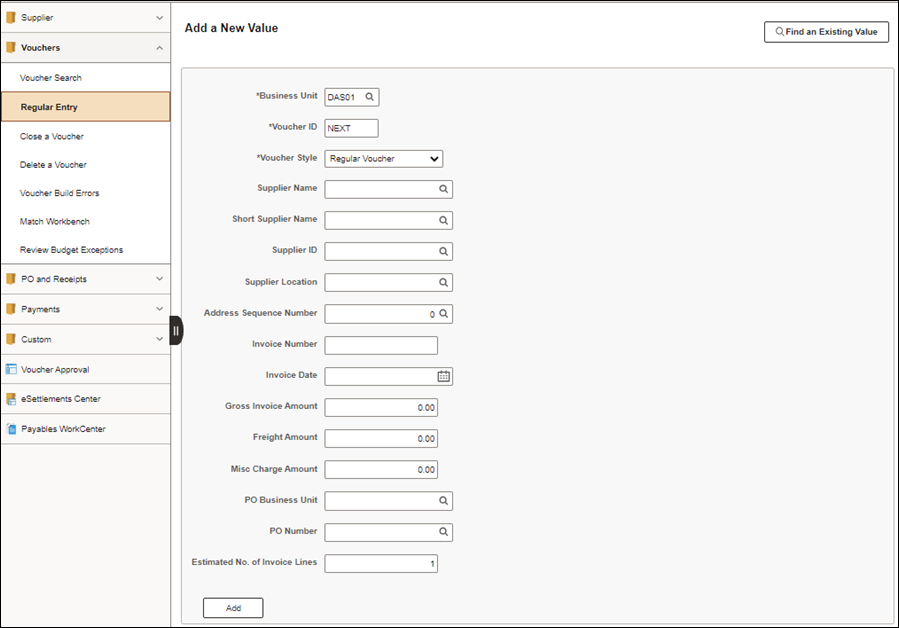
- Leave NEXT in the Voucher ID field.
- OAKS FIN assigns IDs to vouchers.
- Keep Regular Voucher as the Voucher Style for Non-PO Vouchers.
- Click Add.
- The Invoice Information page displays.
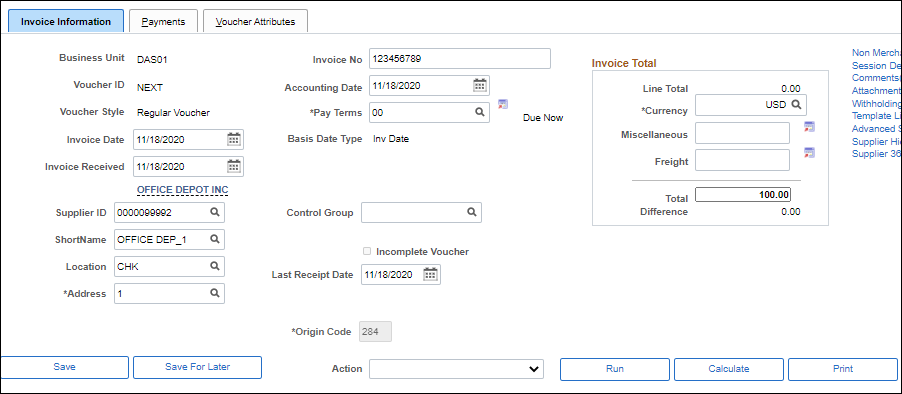
- Select the Supplier ID of the company or individual to send the payment.
- Use the magnifying glass to search for a payee.
- If the payee isn't set up in OAKS FIN, refer the payee to the OhioPays website to register with the state of Ohio.
- Enter the number printed on the payee's invoice in the Invoice Number field (including leading zeros and/or special characters).
- OAKS FIN checks for duplicates when the voucher is saved. The check reviews the following field combinations: Business Unit, Invoice Number, supplier ID, and Amount. The check is not case sensitive. OAKS FIN uses the invoice number as a reference for duplicate invoice checking.
- To avoid duplicate voucher processing:
- If the Invoice Number contains a single space or multiple, consecutive spaces, use only one space whenever a space occurs in the Invoice Number as shown in the following examples:
- Example 1 Invoice Number: 123 - May 2020 (There is a "space" before and after the dash [ - ] and a "space" after "May".)
- Example 2 Invoice Number: 0000567 04 (There is an indiscernible number of spaces following the number "7".)
- For additional guidance on creating unique Invoice Numbers, refer to "Prompt Payment, Invoices, and Vouchers" in the SAFE Manual.
- Enter the date printed on the payee's invoice in the Invoice Date field in MM/DD/YYYY format.
- Discount calculations are based on this field.
- Enter the current date by typing "today" in the field.
- It is the agency‘s responsibility to make sure prompt payment does not begin until the agency receives a proper invoice as defined by Ohio Revised Code Section 125.01(B). If the agency receives a defective or improper invoice from a payee, there are certain responsibilities under Ohio Revised Code (ORC) Section 126.30 that must be fulfilled.
- Utilities regulated by Public Utilities Commission (PUCO) may bill late payment charges based on the rates approved by PUCO. This is not subject to ORC 126.30.
- Except for prompt payment fees and PUCO late fees, late charges of any other type will not be paid.
- Enter the lesser of "current charges" or "balance due" as it appears on the invoice in the Invoice Total field.
-
The total voucher amount must correspond to the invoice amount. An invoice may not be altered by the agency. If the invoice amount is incorrect, the agency should request a new invoice from the payee, according to requirements of prompt pay.
-
The amount entered should:
-
exclude "sales tax" listed on the invoice image when the payee's "remit to" is in Ohio or when Ohio sales tax is explicitly stated (Other taxes such as excise taxes, local taxes, environmental taxes, or other types of taxes are not exempt from payment by the state and should be included) .
-
Enter the date on which the state received the proper invoice in the Invoice Received field.
- This is not the date on the payee invoice. It is the date the invoice was received and deemed a valid invoice. Interest calculations are based on this field.
- Enter the date on which the goods or services were received in the Last Receipt Date field.
- A correct Last Receipt Date must be entered. Procedures for determining the correct last receipt date are issued by OBM Financial Support Services.
- Refer to the "Determining Last Receipt Date" topic for guidelines.
- Verify that the Address is the one from which the invoice was sent. If the default address is not the one used for this invoice, use the magnifying glass to select a different address.
- Verify or edit Pay Terms.
- The Pay Terms will default to "Due Now" or to the pay terms specified on a contract when a Contract Number is referenced.
- Correct usage of vendor Pay Terms allows OAKS FIN to calculate late interest charges, early payment discounts, etc. based on the Invoice Date.
- Add Attachments in the Header.
- Items such as invoices or backup documentation must be added by the Voucher Processor.
- Select the Attachments link.
- The Voucher Header Attachment page displays.
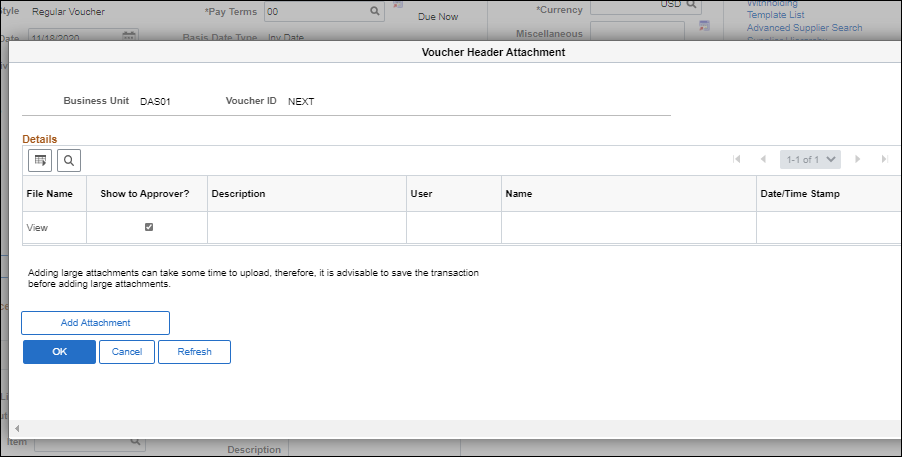
- Click Add Attachment.
- Browse to find the appropriate item and then click Upload. Five attachments can be uploaded at a time.
- Click OK.
- The Invoice Information page displays and the number of attachments is listed next to the Attachments link.
- Enter the method by which to allocate or charge the expense account distribution in the Distribute By field.
- Verify the Distribute By field has defaulted to Amount.
- For purchasing items via a contract, enter item information for each item purchased.
- Look up and select the Item number.
- Use the magnifying glass next to the Item field to select this value so that other fields, such as Description , will automatically populate.
- The Unit of Measure (UOM) is required for state term contracts.
- Select Calculate.
- This checks that the Invoice Total in the Header is equal to the sum of all the Invoice Lines and that the Extended Amount and Distribution Amount on the selected invoice line are equal.
- If the distribution lines do not equal the merchandise amount, OAKS FIN displays an error message when saving the voucher.
- Verify or select a new Ship To value for the agency.
- The Ship To will default based on the Origin code entered.
- Select a SpeedChart value.
- SpeedCharts are optional and used as a shortcut to enter frequently used ChartField combinations thereby reducing keystrokes. When SpeedCharts are used, the Distribution Line pre-populates so there is no need for any manual Chartfield entry.
- Enter or select the Term Contract ID - that is, the contract number.
- If the payee is eligible, the MBE field is editable. Select MBE or EDGE to receive credit.
- If the payee being paid is a certified Minority Business Enterprise (MBE) or Edge payee and the certification is current, the MBE field will be editable, and the MBE or Edge designation can be chosen. Make the selection at the time of voucher entry to receive MBE/Edge credit. OAKS FIN does not track missed MBE expenditures.
-
If a SpeedChart is not used to define the ChartFields, enter the coding information manually. Enter at least Fund, Account, ALI, Department , and Service Location.
-
Enter additional ChartFields according to the agency's standards.
-
It is possible to charge the entire amount of the voucher to a single ChartField distribution line or to split the cost into multiple distribution lines. For example, two distribution lines can be used to split the cost between two different departments or divisions. However, the total of the Amount field on all the distribution lines must equal the amount displayed in the Extended Amount (merchandise amount) field.
-
The appropriate account code must be used. Account code definitions are issued by OBM Financial Support Services. Account code definitions may be updated periodically during the year.
-
Reference the OAKS FIN Accounts Code Table Online Reference for guidance.
-
- In some instances, agencies must consider the cost per individual item being purchased to determine if the goods should be considered a supply or equipment. If the invoice contains both equipment and supplies (items with a per unit cost of $1,000 or more and items with a per unit cost less than $1,000), each line item must be coded accordingly and placed on separate lines on the voucher
- For items with a per unit price of $1,000 or more.
-
- For the purchase or lease of supplies, items and/or equipment with a per unit cost of $1,000 or more use an account code within the 53xxxx series (equipment).
- For items with a per unit cost of less than $1,000
-
- For the purchase or lease of supplies, items and/or equipment with a per unit cost of less than $1,000 use an account code within the 521xxx or 524xxx series (supply).
- To enter asset information select the Assets tab and check the Asset check box to make fields available to enter the appropriate Asset Management (AM) Business Unit and Profile ID for the line item.
-
For additional information about coding asset information refer to the Asset Management topic.
-
When using a capital expense account, the Project ChartField will also become required.
-
Click the Payments tab.
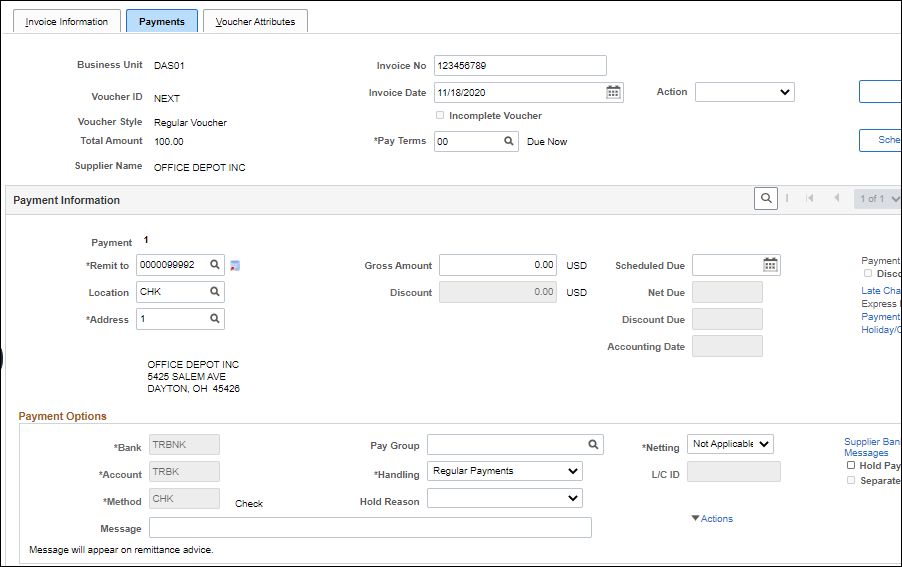
-
Use the Payments tab to view payment related details for this voucher, including payment method, schedule, and options information. OAKS FIN displays the information on the Payments page based on the detail set up in the payee record such as payment terms, default location, and handling code.
- Verify or edit the Handling field (under the Payment Method section.)
- This field specifies who mails payments. The default is "Regular Payment." The options are:
- Return to Agency: Warrant (Check) are returned to the agency for mailing.
- Regular: Warrant (Check) are mailed centrally.
- Liens: OBM uses this code for lien processing.
- Bond Payments: Warrant (Check) are sent to OBM for processing.
- Select the correct payee Location (payee payment method) using the Look up Location icon that corresponds to the Address Sequence Number selected. The payee Location and Address Sequence Number must always match if payment is to be made by EFT, (e.g., select "EFT-2" if Address Sequence Number "2" is selected). If EFT does not have a corresponding address, use "CHK."
- EFT must be selected when available.
- The Address field contains the address from which the payment was received. The address located in the Payment Information section indicates where the payment is to be sent.
- Often, payees will use a different address for the address shown in their letterhead to receive payments, known as a "remit to" address. Use this Address field to indicate where the payment will be sent.
- The Bank and Account fields are not editable. They specify the account from which payment is drawn.
- The Method field displays the payment method for a voucher. The Method field cannot be edited; it is determined by the location entered.
-
Add a Payment Message.
- There are 2 methods for entering Payment Messages: manually (using the free-form Message field) or selecting an agency-specific pre-defined message (using the Messages hyperlink). Both messages will display on the Warrant (Check) (CHK) stub (up to 70-characters), but free-form Messages will not display on EFT.
- To apply a pre-defined message to the Warrant (Check), click the Message link in the payment method section.
- To hold a payment, select the Hold Payment checkbox.
- Select the Hold Reason.
- Remember to resolve the reason for the hold and to remove the hold as quickly as possible.
- The Reference field currently does not display any information. Once saved, a voucher and the pay cycle occurs, OAKS FIN displays the Warrant (Check) or EFT reference number in this field.
- Click the Voucher Attributes link to view the overall voucher status and entry information on the voucher, such as accounting instructions and approval information.
- The Voucher Attributes page displays.
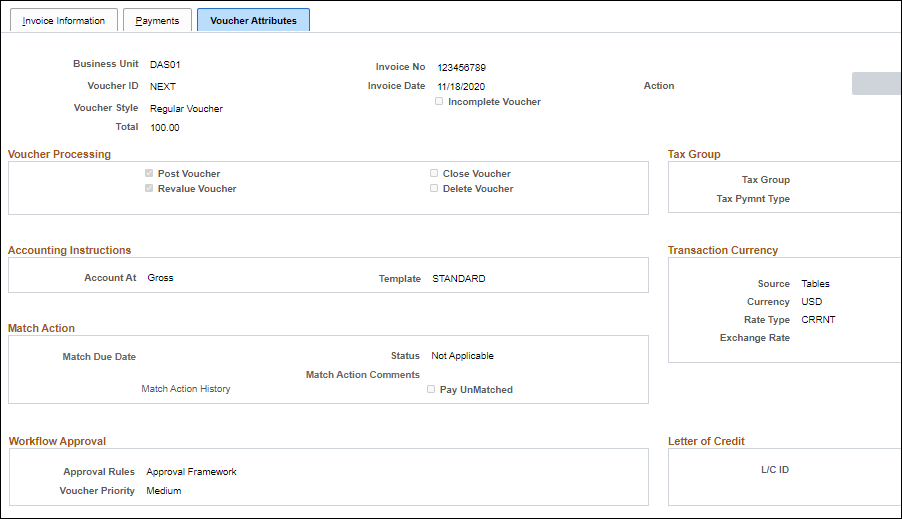
-
Review the voucher information, such as accounting instructions and approval information.
-
The voucher processor can change the Pay Terms on the voucher during voucher creation; however, once the voucher is saved, OBM Financial Support Services must be contacted to revise the scheduled payment terms if necessary.
-
Click the Invoice Information link or tab to go back to the Invoice Information page.
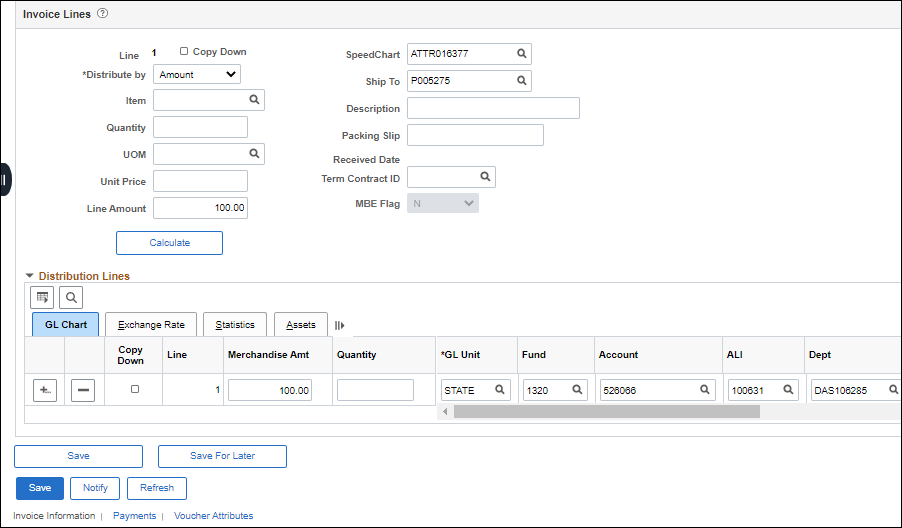
-
The Print button allows the agency to print a voucher.
-
Click Save or Save For Later.
-
The Save for Later function allows users to save vouchers that are in progress but not completed; users can come back later to complete the voucher. The following details are required to use the Save for Later functionality.
-
Payee Information
-
Account Code
-
Last Receipt Date
-
Invoice Date
-
After a voucher is saved for later, a voucher number will be created, but no voucher balance or combo edit checks will be performed. OAKS FIN automatically assigns the next sequential number in the Voucher ID field. A status of Incomplete (“I”) will be displayed and the voucher will not be routed for approval. Instead, it will go into a recycled status and be displayed in the Voucher Processor’s WorkCenter.
-
OAKS FIN assigns the next sequential Voucher ID number to the voucher.
-
Another Voucher Processor with the same security may complete the pending voucher.
-
If saved for later, a status of Incomplete (“I”) will be displayed and the voucher will not be routed for approval.
-
-






